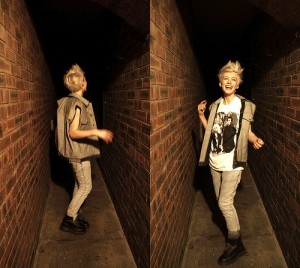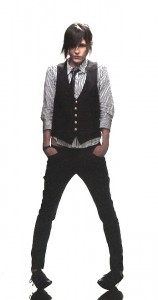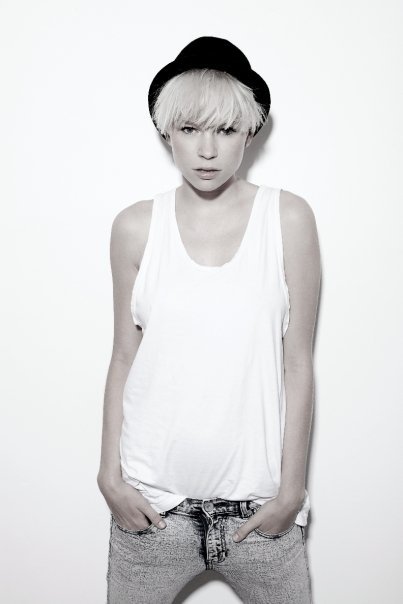WHY ARE WE still interested in the lesbian hipster? In part it’s because we can’t stop lurking around her pictures on Facebook, which are beyond cute. But it’s mostly because the “lesbian” and “hipster” worlds seem to have converged so naturally that there’s clearly something going on past Generation X/Y’s universal adoption of any eastward-blowing trend-wind.
Remember that time back in the 80’s when power suits were all the rage? Trends may come and go, but once in a star-crossed while, styles work their way permanently into various subcultures. Lesbian hipsters are one of the newer members of the already highly categorized girl-on-girl community, but within the lesbian subculture, does this trend have the power to outlast the shelf life of the mainstream hipster, just as “power lesbians” kept the power suits?
Despite its relative newness, the lesbian hipster style is almost ubiquitous in certain spaces, like Tegan and Sara concerts or The Abbey in West Hollywood on a Friday night. So why does hipster jibe so easily with lesbian? The answer lies in history, or hipstory, if you will. I know, it’s hard to believe that all these thrift-shop-shirt-wearing, gold-lamé-legginged girls carry with them any sort of legacy beyond 80’s dance movies (Jennifer Beals, I’m looking at you).

A subculture creates its own style to distinguish itself from the mainstream culture. These subcultures usually arise from some form of societal oppression, and, as women and as lesbians, we know all about oppression. Once the style becomes distinctive as a symbol of resistance, dissent, or even difference, American popular culture reacts not in fear but instead by picking and choosing what can be reinterpreted and then marketed to the masses as trendy. Oversaturation turns the outlandish into the normal and the do-it-yourself into the mass-produced. Suddenly what began as dissent becomes a trend. This sort of appropriation of subcultures allows us to buy into the edginess of rebellion while bypassing its troubled history.
The Hipster as a Third Gender
Despite the fact that I walk around all day looking like a big giant lesbian with the ability to wear a bandana at  least six different ways and a haircut whose tell-tale lack of symmetry can be spotted even by a novice, I still unintentionally pass as straight. Not just in the way that everyone assumes everyone else’s heterosexuality, but in the way that I can wear a tie, use the word “girlfriend” non-platonically, and still be actively pursued by men.
least six different ways and a haircut whose tell-tale lack of symmetry can be spotted even by a novice, I still unintentionally pass as straight. Not just in the way that everyone assumes everyone else’s heterosexuality, but in the way that I can wear a tie, use the word “girlfriend” non-platonically, and still be actively pursued by men.
It must be due to my extraordinary good looks. But most likely this is due to the fact that hipster style tends to be androgynous. Aside from the ironic mustache (some of the time), most hipster trends are suited to fit both guys and girls. What was once “boys in girl pants” has now just evolved into “skinny jeans,” and any clothing items once sized large enough to fit only men have been shrunken down to skin-tight. Hipster seems to be functioning as a third gender in fashion.
It’s not uncommon in many non-Western cultures for a third or more genders to be recognized in society, although it’s a phenomenon that makes most Americans—not to mention our health care system—very uncomfortable. While the third-gendered peoples are generally accepted in these pre-modern societies, and were often revered as shamans, this acceptance tends to come at the price of their sexuality. Basically, in order to avoid that whole confusion over reproduction and gender binaries and such, these individuals were generally regarded as asexual.
 But not to worry, lesbian hipsters—we still think you’re hot. Hipsterdom may be viewed as somewhere in between genders, but identifying yourself as a lesbian means not only identifying yourself as a woman but also basing your identity upon your sexual orientation. Given her ambiguity on these dimensions, the lesbian hipster has universal appeal. Her style is just new enough to be trendy and sexy, while the items in her wardrobe are familiar enough to be safe for the whole family.
But not to worry, lesbian hipsters—we still think you’re hot. Hipsterdom may be viewed as somewhere in between genders, but identifying yourself as a lesbian means not only identifying yourself as a woman but also basing your identity upon your sexual orientation. Given her ambiguity on these dimensions, the lesbian hipster has universal appeal. Her style is just new enough to be trendy and sexy, while the items in her wardrobe are familiar enough to be safe for the whole family.
Advanced research has shown that the hipster lesbian is typically perceived by straight men as “just an edgy straight girl” and by straight women as “that cute lesbian I would totally go gay for.” Which is all well and good for walking around being hipster cool, but what does it mean in the world of lesbian? Once again, we’ve got Tegan and Sara to thank, maybe not exclusively, but in large measure, for making the lesbian hipster cool. Always appearing with swoopalicious bangs, ankle-choking jeans, and trendy T-shirts, Tegan and Sara made lesbian hipster not only acceptable, but also attractive. However, dressing like these girls does not a trendy lesbian make.
Because, after all—we must face facts—hipsters are sometimes ridiculous. Take it from someone who has actually been turned down for being “too hipster”: not everyone is into it. This is potentially because hipsters, like members of any fashion-oriented subculture, have a tendency to flock together, which carries the risk of producing a culture of exclusivity. Luckily, the queer girl community holds a stronger bond than the hipster one does, allowing the lesbian hipster to socialize freely among other lesbians. In fact, her conspicuous appearance at lesbian gatherings may even attract girls who are drawn to her style. The hipster, for her part, just shouldn’t expect to pick up all of them.
To illustrate this point, I present the separate histories of the lesbian hipster’s three-piece suit: a plaid shirt, a bandanna, and skinny jeans.
The Plaid Shirt. Don’t you go around calling this lesbian staple your “lumberjack shirt.” Unless, of course, you are a lumberjack, in which case you would probably just call it your shirt. But believe it or not, plaid was once so controversial that English authorities banned the pattern after the Scottish rebellion in the late 1740’s. Yes, before becoming insufferable, Mel Gibson taught us in Braveheart that plaid means business. More recently, you ought to know that plaid shirts were donned by women’s libbers in the 1960’s, proving you don’t need to be a man to wear a button-down.
The Bandana. Bandanas are so gay that Peaches wrote a song about them. “Hanky Code” poetically weaves the tale of a system of colored handkerchiefs used by gay men in the 70’s to indicate their sexual preferences and fetishes. And even though bandanas have gone fairly mainstream as a fashion item and are now popular lesbian trademarks, you probably still shouldn’t casually walk into an S&M workshop with a bandana hanging out of your back pocket. Other than that, you go for it, girl.
Skinny Jeans. Super-tight straight leg pants, worn notably by sex symbols and rebellious icons of yore such as Elvis Presley and James Dean, made it big in the 1970’s underground punk scene. The pants’ popularity stayed alive through the decades, persisting largely through other music scenes. And although skinny jeans were once—and still are—the choice pants of rock stars and those looking to fight The Man, they have now joined the ranks of the lesbian subculture so that you too can experience the awkwardness of hooking up with someone, running into trouble trying to get your jeans off, having to hop around the room while slowly working them off your ankles, and finally ending up with a pair of inside-out skinny jeans on the floor. Ready when you are!
The Place of the Hipster
What, then, can be said about the place of the lesbian hipster in the queer girl community? She’s a different kind of lesbian, paying tribute to the subcultures that came before her. Or maybe she’s just a girl who thinks solid-colored V-neck T-shirts make her look hotter than any other kind (she’s correct).
Androgynously sexy and dykey but not quite butch, the lesbian hipster creates her own categories by falling in between earlier ones. Hipsters get their clothes from lesbians, and lesbians get their clothes from hipsters; maybe this means there are no lesbian hipsters or even hipsters at all, there are just lesbians—and straight people who dress like them. We invited the lesbian hipster over, and now she’s here to stay. Perhaps for tea, preferably a trendy variety like rooibos, served in a thrift-store 4-H mug. We won’t even kick the lesbian hipster out the next morning. In fact, maybe she can move in. Maybe we can get a cat and name it something like Jane Lynch or Shane Jr.
But alas, much to the chagrin of heterosexual hipsters, the look will pass. Autostraddle.com predicts that for gay ladies, however, the trend will stay. It’s the same reason we want the lesbian hipster herself to stay. These trends are giving queer girls what we’ve always deserved: hotness on our terms.
The lesbian hipster style provides us with the perfect outlet for androgyny, which we all already know to be sexy. It’s a middle ground of gender. Androgyny is Hipsterdom’s gift to lesbianism. We can still be girls without having to be too girly. It’s like in the 80’s, when women in the business world adopted power suits, and some lesbians held on to them even when they went out of fashion (Bette Porter, anyone?). They aren’t our means of access to power, but they’re still a symbol of our empowerment.
Such is the case for today’s hipster. Dressed once in full hipster clad for church (a different story entirely), I was told by my mother that I had to change so as to look like a girl. Thanks to hipsters, we no longer have to take it when our moms tell us to look like girls. We know we’re girls. Nay, we are women (womyn?), and we are so hip and cool that we don’t need frills or poofs or heels or whatever they’re selling us as emblems of femininity these days. The lesbian hipster is confident; she knows who she is and what she wants, and she’s wearing her little gay heart on her plaid sleeve.
Katrina Casino is an editor at Autostraddle.com, a website covering political and cultural topics of interest to younger lesbians. This article is adapted from a piece that first appeared on Autostraddle.com.






